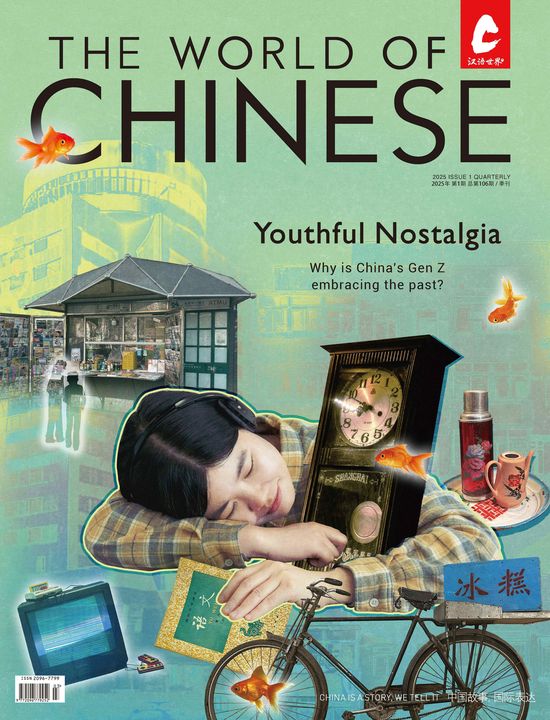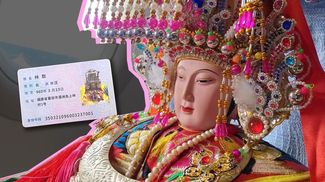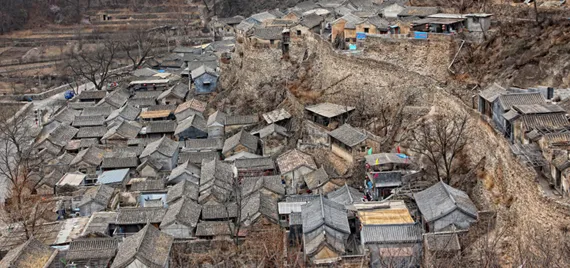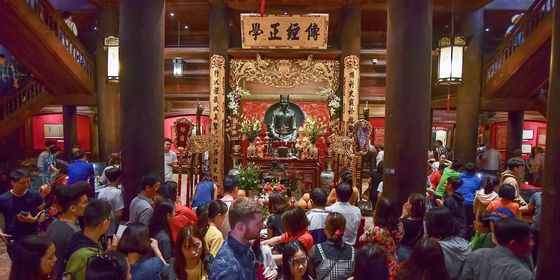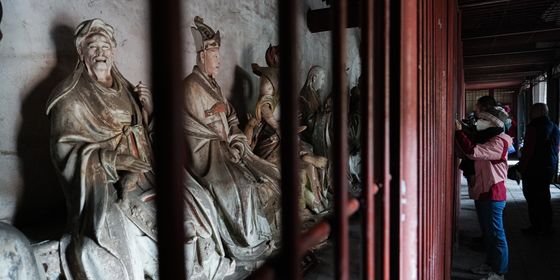A few days of nights in the hilly outskirts of Beijing in search of Han and his honey
Through dusty prairies and Northern landscapes of mostly brown and grey, intermittent hills carved millennia ago and sometimes visibly capped with stretches of the Great Wall, run through a few small, scattered lakes and towns, a nuclear reactor and the idiosyncratic bric-à-brac of outskirt industries in China. The bus from central Beijing had been rumbling along for over two hours on the way to the somewhat, if not perhaps artificially, sealed-in-time village of Cuandixia (爨底下).
Drawn to Cuandixia by photographs of narrow lanes and promises of the freshest honey in North China supplied by the beehives of the Han family, one early weekend morning, we, my girlfriend and I, packed our bags for a few days of nights in the hilly outskirts of Beijing and ventured in search of Han and his honey. Some trips are better planned, broken down and researched, and others are simply ready for discovery and adventure. From mischievous grins with each request for directions to Mr. Han’s guest house to the graffiti of a recent Chinese past scrawled in red on ancient walls and the realization of Mr. Han’s identity, the trip unfolded in that piquant way that only miscommunications and small trips in China can.
Beijing is broken into a total of 16 districts, from its cosmopolitan city center and polished towers to sleepy villages over 100 kilometers away. Cuandixia is located in Mentougou District in the far west of Beijing, bordering Hebei Province. With a population of about 300,000, Mentougou has the lowest population density of Beijing’s various districts. According to geological data, Mentougou, boasting over 100 peaks, is roughly93 percent mountains, a topographical feature that has contributed to its low population density, history of bucolic isolation and popularity with hikers today. Like Fujian Province and some other parts of China, depressions amid the rolling hills have created microcosms where populations fleeing the wars of China’s past have settled.
Coming from the PM2.5 air quality concerns, the glass and steel, the pace and demands of Beijing, the mountain air and infectiously relaxing tempo of Cuandixia seemed ideal for a short term escape. Cuandixia serves such purposes as a roadside inn, a stopping point to warm and feed along ancient trade routes, a burning fire kept warm to protect and nourish travelers and residents since it was established in the Ming Dynasty (1368-1644).
The bus dropped us off at the nearby town of Zhaitang (斋堂). It slowed down at a dusty roundabout for us to disembark before sputtering away. As we stepped off the bus a group of men dropped their cards and rushed up to greet the two foreigners with backpacks, offering to drive us the rest of the distance into Cuandixia. They knew where we were headed because, well, why else would people go to Zhaitang. After a snack of dry fried green beans and rice, we found a driver who would take us into the village.
He introduced himself as Li Wei, a native of Zhaitang, and offered to take us to the park for 35 kuai, the entrance fee for the park surrounding Cuandixia. The ride itself was free. Since nobody in the village would check or care whether we had a ticket, he assured us, there was no reason to give our money to the tour company that decided to start charging people to pass through an arbitrary gate. “Leave it to the tourists,” he joked, as if we were suddenly natives of Zhaitang like him. We opted to participate in the somewhat illicit local game. After we agreed, he told us that he, and many other drivers, had a deal with their friends at the gate. They would circumvent the paper tickets and split the money.
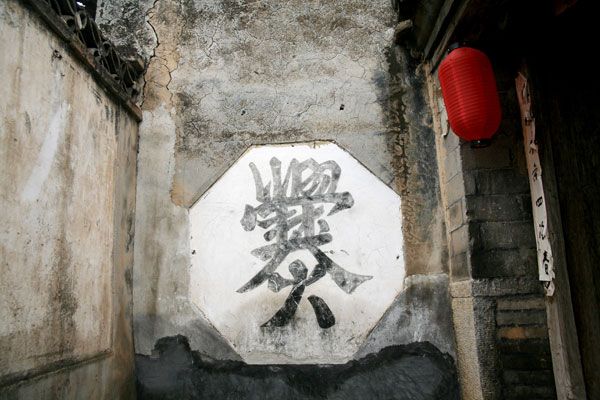
The all-too-important character of Cuandixia, one making it a village and a sanctuary
As we rumbled along the last leg of the country road, we chatted about the village. Well informed, Mr. Li told us about the significance of the name, Cuandixia, how etymologically it is tied to its founding history. 爨, is a particularly complicated character; it is composed of 29 strokes, while the average number of strokes in the 3,000 most frequently used Chinese characters is about 9. 爨 means stove, but for the residents, Mr. Li explained energetically, it carries the significance of, not just warmth and food, but also shelter and protection. The rest of the name, 底下, means the land below, or away from. As the first residents settled in the little valley hundreds of years earlier, they found it a source of relief from the darkness and conflict that had taken them there. Giving rise to the symbolism of an area that provides safety from the furnace of war. The legends and meaning may have blurred a little over time but residents and neighbors like Li Wei still speak of the significance of the name in that particular way many Chinese people discuss the etymology of a unique character.
We said goodbye to Mr. Li on the cobbled stones at the base of Cuandixia; the village’s 500 some little stone courtyard houses rise organically up the side of the hill. We made our way up the winding stone steps, passing little houses with wooden gates and bright teal or red good luck posters. Every house had corn hanging from its rafters and above its moon gates.
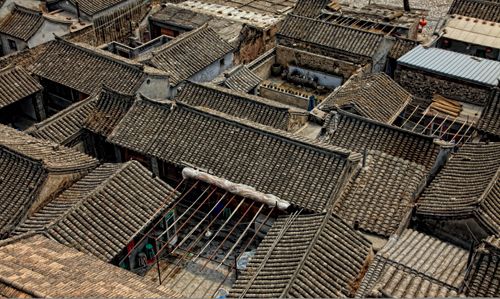
A bird’s eye view of an ancient and mysterious getaway so near the heart of Beijing
We approached a smiling woman walking up the steps in front of us and asked her if she knew where to find Mr. Han, who we were told to ask about honey. She nodded and mischievously pointed sort of universally around and scampered onward. Confused by her gestures we continued to ascend the uneven stones rising narrowly between oblique Ming and Qing Dynasty houses. An old man with thick glasses came around the corner of a dilapidated wooden gate that was wreathed in wires and hibernating vines. He acknowledged us behind his dense lenses and chuckled at our question. From the way he squinted, we were unsure if he could really see us standing in front of him. He asked which Han we wanted. I explained that friends of ours had told us to ask for a certain Mr. Han who had hosted them a few months earlier. He laughed a little and said he didn’t know who exactly we were looking for but that there were many Mr. Hans in Cuandixia.
Perplexed, we walked a little more, exploring the beauty of this ancient place, its tight corners and the looming peaks that carried our eyes upward. Having passed several guesthouses already, and unsure about our exact Mr. Han, we selected a place called Caizhuyuan Kezhan (彩珠源客栈) or Richman’s Courtyard Guesthouse.
The little courtyard house was the residence of the former head of Cuandixia and the layer above us used to host a larger courtyard, a temple and an administrative building that now collects dust and cobwebs. The tiny room was sufficient, but we felt we should take one more chance at finding our man and asked the proprietor if they knew a Mr. Han. Grinning with the knowledge of an inside joke, as if this confusion was commonplace, the elderly couple glanced at each other and then back at us. Here, in Cuandixia, they revealed, everyone is surnamed Han, descended from the same clan of refugees.
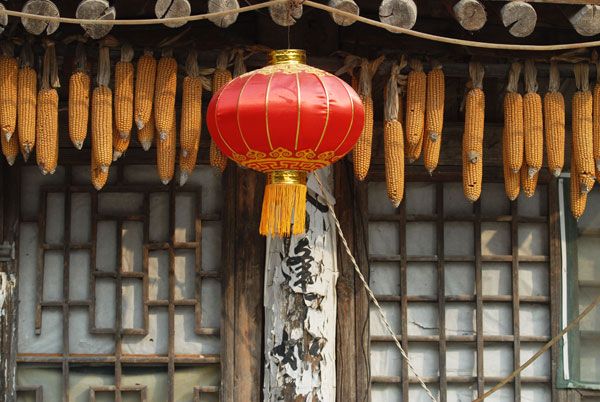
Corn dries in rows outside a house in Mengtou District, so far from the horns and smog of Beijing
Chinese history is rich with internal conflicts. The war of the Three Kingdoms, among the most popular in Chinese literature, begins with the famous line “Empires wax and wane.” And many centuries later, during the Ming Dynasty, the Han clan of Shanxi had had enough of such vicissitudes and decided to flee for a more stable home in the security of the hills. Moving eastward from Shanxi Province, hundreds of kilometers away, they finally settled into a little depression in the Jingxi mountain range. To this day, the clan of Han stirs the cooking fires of Cuandixia and opens their doors to travelers.
Feeling foolish, we joked with each other about how long we might have scoured the cobbled paths in search of one mysterious Mr. Han. As we placed our bags in our cozy little room our aging hosts regaled us with another favorite local story. The monk Han Shoude, a villager who is said to have resembled the Qing dynasty Kangxi Emperor (1654-1722), was responsible for the growth and beautification of the village, he secured the imperial funds that made it possible for the grander buildings and courtyards that now form Cuandixia. The pride of a connection to imperial approval was apparent in our hosts, and our Mr. Han cocked his head and asked us if we thought he looked like anyone famous. We pretended to take photos of the celebrity with invisible cameras for a few moments before
heading out to explore the village before dinner.

A hearth of incense, an apt symbol for this political oasis
After a few hours of exploring the labyrinthine cobbled lanes and the terraced hill above, spending some time at a little temple with its bronze incense
boat and gnarled tree, we returned to our guesthouse. The amicable Hans that ran Caizhuyuan grinned and offered us flashlights for the night and asked if we were hungry. We accepted. While Mrs. Han sequestered herself in the small kitchen on the opposite side of the courtyard from our room, Mr. Han prepared our heater. At the foot of our bed there was a small iron grate that opened into a hole in the stone floor. The hinges exhaled as Mr. Han pulled back the lid with
one hand before putting in a small handful of kindling with the other. We watched as he bent there, with a small lighter he sparked a torn piece of newspaper and then ignited the kindling. He blew several bellowsful to stoke the spark before placing a few small pieces of white wood onto the flame and closing the grate. The heater beneath our feet crackled several times as it came to life.
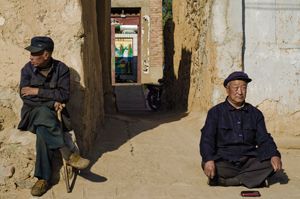
Two Cuandixia residents pass time in the cold light of the sun
A few minutes later Mrs. Han entered with our food. We asked for a bowl of dough drop soup, pork fried with peppers and something they highly recommended, eggs fried with Chinese Toon, a tree member of the Mahogany family reported to have several benefits in Chinese medicine. The earthy taste is reminiscent of mushrooms. We ate our meal in our room listening to the snapping embers below the floor and enjoying the wafting aroma of burning pine as it mixed with the fragrance of our dinner.
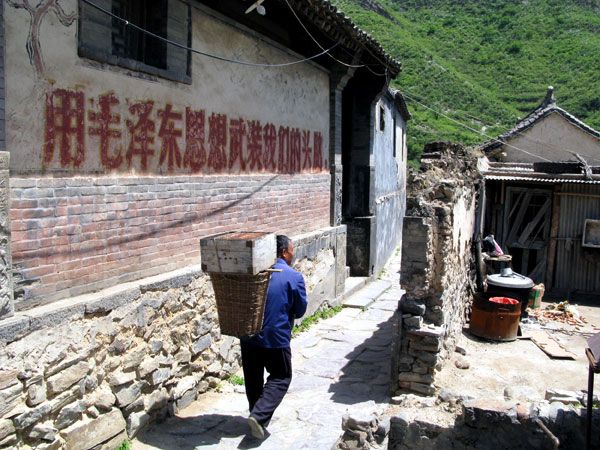
A relic of the Cultural Revolution painted on a Cuandixia wall
The next morning we woke early and ate flat bread cooked with spring onions. We set out to hike the hill opposite the village. In early morning, frost dusted the limestone and granite hills with a gentle white. The fields, fences and ubiquitous hanging ears of corn glistened with hoarfrost. By midmorning the sun warmed the soil and melted the frost from the branches and grasses. Reflective minerals in the granite seized clouds broke to demonstrate their luster amid the golden husks of previous years’ corn. Tufts of juniper amid the brown skeletons of deciduous residents welcomed us as we rose far above the village, tantalized by the unfolding landscape. We lingered on the bluff above, glancing down at a place where time and people have come to an uncommon arrangement.
Returning to our guesthouse after our descent we noticed a couple red slogans, leftovers of the Cultural Revolution, clinging to the mortar around a corner or a wall where we hadn’t looked earlier. It occurred to us that despite its poetic metaphors Cuandixia suffered in the 20th century. On one wall I read a curse to the Japanese, no doubt written during or in reference to the Sino-Japanese War (1937-1945). One slogan, scrawled on the brick outside our guesthouse, praised Mao Zedong Thought and urged the reader to employ it in their daily life while another, in slightly more faded characters, praised the People’s Liberation Army. Had Cuandixia been overrun with public violence during these episodes or had the legend protected them? Our host assured us that “the Cultural Revolution was not that bad”.
All that remains of those times is what is still stained on the walls. In the last few years, Cuandixia has grown from a secret gem to a known but still seldom visited destination, and the residents have trickled away. The issue of internal migration, rural residents moving to cities in search of better paying work, is a national issue. Cuandixia has recently faced the same problems as other villages in China. Today, primarily only the elderly remain. Those of working age have left to take jobs in factories or salons in Beijing, Hebei Province or Shandong Province. Some return, others don’t. This was apparent as we walked around the village, looking into so many wrinkled faces.
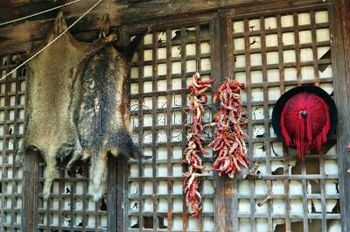
Animal skins, peppers and a hat adorn this sleepy home deep in the mountains outside Beijing’s capital
The parents and grandparents of Cuandixia remain to manage guesthouses. The village is a truly northern Chinese caravansary, as practically every old courtyard house has been converted into an inn. Each guesthouse has a kitchen and modest menu and every resident of Cuandixia seems to keep bees. Every locale in China has its special local product, and Cuandixia is best known for its honey production. That was, after all, one of the reasons we ventured there in the first place. But the reputation is perhaps undeserving. Of the five or six jars we tasted, none boasted the thick, speckled and opaque, handmade honey we had hoped for. Although, it was still much cheaper than honey you would find in the city. Perhaps there was something of a metaphor there to take with us rather than a small jar of honey: the sweetness of a sleepy leftover, yet unspoiled by the rapid development of modern Beijing so close by.
In the end we never bought a jar of honey, but as we drove away, I hoped that our recollections of fragrant pine and stunning vistas, hanging corn and humble courtyards, would linger to keep a bit of our escape from the city alive as we returned to the pace and demands of Beijing.
Photos courtesy of Noemi Cassanelli.
